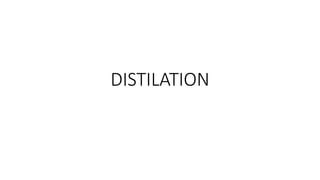
Second Year.pptx
- 1. DISTILATION
- 2. DISTILLATION UNDER REDUCED PRESSURE (VACUME DISTILATION) • The distillation Process in which the liquid is distilled at a temperature lower than its boiling point by the application of vacume. • Vacuum distillation is ideal for separating mixtures of liquids with very high boiling points ( more than 150 )or compound when decompose at high temperature. • Vacume Pump, Suction Pump etc are used to reduce the pressure on the liquid surface. • Distillation under reduce pressure is based on the principle of the simple distillation with some modification.
- 3. Principle: • Liquid boils when vapour pressure is equal to the atmospheric pressure i.e. pressure on the surface. If the external pressure is reduced by applying vacume , the boiling point of liquid is lowered. There fore liquid boils at lower temperature. EXAMPLE: Water boils at 100 c atmospheric pressure 760mmHg but at 40 c water vapour pressure is reduced 70mmHg.
- 5. STEAM DISTILLATION • Steam distillation is used for the distillation of two immiscible liquids one of which is water. • Application: • (i) Separation of volatile oil e.g. eucalyptus oil, rose oil, clove oil etc. and • (ii) Preparation of some aromatic water e.g. concentrated rose water..
- 6. Theory • Volatile oils are mixtures of high molecular weight compounds having low vapour pressure (i.e. high b.p.). To separate these from the natural sources like petals of flowers, barks etc. it is not possible to take them to their boiling points around 200C. If these oils are distilled with water (low molecular weight but high vapour pressure i.e. low b.p.) then volatile oil will be distilled out at a temperature below 100C. • The aqueous phase of distillate that is collected is water saturated with volatile oil i.e. called aromatic water.
- 8. MOLECULAR DISTILLATION • Molecular distillation is a type of short-path vacuum distillation, characterized by an extremely low vacuum pressure (≈ 0.01 torr). • It is a distillation process in which each molecule in the vapour phase travels mean free path and gets condensed individually without inter- molecular collisions on application of vacuum • This process is characterized by short term exposure of the distillate liquid to high temperatures in high vacuum in the distillation column and a small distance between the evaporator and the condenser around 2 cm. • It is a process of separation, purification and concentration of natural products, complex and thermally sensitive molecules.
- 9. Principle: • Molecular distillation is considered as the safest mode of separation and to purify the thermally unstable molecules and related compounds with low volatility and elevated boiling points. • The process distinguishes the short residence time in the zone of the molecular evaporator exposed to heat and low operating temperature due to vacuum in the space of distillation. • The separation principle of molecular distillation is based • on the difference of molecular mean free path. The passage of free path for molecules should be collision free.
- 10. • Langmuir and Knudsen derived an equation which describes the yield of distillate for molecular distillation.
- 11. Falling Film Molecular Still • The vessel has a diameter of the order of 1 m and the walls are heated suitably by a heating jacket. • Vacuum pumps are connected by a large diameter pipe. • The feed flows down the walls and is spread to a film by the polytetrafluoroethylene (PTFE) wipers which move about 3 m/s giving a film velocity of about 1.5 m/s. • The residue is collected at the bottom of the vessel and it is re-circulated (through the feed line). • The evaporated molecules are then condensed on the condenser surface. The condensate is taken out as product.
- 12. Centrifugal molecular still • The distilland (feed) is introduced on to the center of a bucket-shaped vessel (1 to 1.5 m in diameter) that rotates at high speed. • The film of liquid that is formed moves outwards over the surface of the vessel to the residue collection pipe. • The vessel is heated by radiant heaters. Condensers and a collection device are located close to the inner surface of the rotor.
- 13. Advantages: • (i) Toxicity: Avoids the problem of toxicity of solvents used as the separating agent. • (ii) Thermal stability: Minimizes losses due to thermal decomposition. • (iii) Continuous process: It can be used in a continuous feed process to harvest distillate without having to break vacuum. • (iv) Stability: The vacuum allows oils to be processed at minimal temperatures, reducing the risk of oxidative damage. • (v) Purity: Separating the oil’s components by weight allows contaminants to be reduced far below industry standards. • (vi) Concentration: Weight grouping allows the processor to concentrate fatty acids. (vii) Short residence time: This process has short residence time of the feed liquid. (viii) It works at a significantly lowered temperature due to high vacuum capability (ix) It has optimal efficiency in mass and heat transfer. (x) It is suitable for processing high value products
- 14. Disadvantages: • . (i) Cost: The cost for this complicated technology is relatively high. (ii) Natural form: The starting natural triglyceride form is lost in the distillation process.
- 15. Applications: • (i) It is used for separation of vitamins and polyunsaturated fatty acids. (ii) Molecular distillation is used industrially for purification of oils. (iii) It is also used to enrich borage oil in γ-linolenic acid (GLA) and recover tocopherols from deodorizer distillate of soybean oil. (iv) It can be used for the production of synthetic and natural vitamin E, (v) Capsicum red pigment containing 1% to 2% of the solvent can be separated after two stage molecular distillation. (vi) It is used for separation of strong spices like volatile substances.